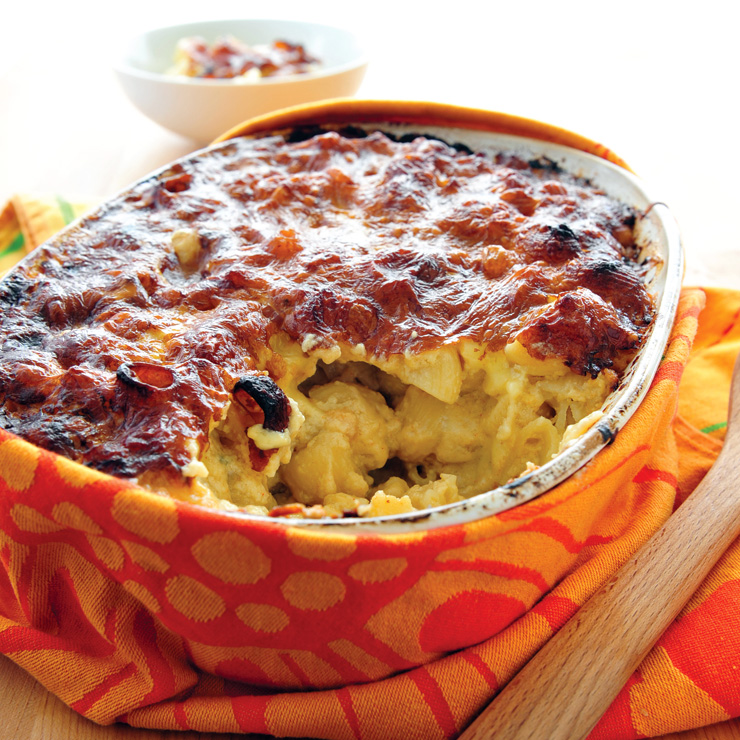
Traditional American barbecue is just one style of smoking. Food can be smoke-cured to preserve it and remove moisture; it can be smoke-roasted or cold-smoked to add flavor with little cooking.
Traditional American Barbecue
To most, barbecue, as a rule, means cooking food with wood smoke for long periods of time at low temperatures — "Low and Slow." A dry rub is typically used during the smoking process, and some styles of barbecue will add a sauce after the smoking is complete or near the end of the process. Barbecue temperatures are usually around 200°F, but many do it lower or higher. Barbecue aficionados take pride transforming lesser cuts of meat into tender masterpieces. The key is taking the time to break down the connective tissue and render the fat without going too far and drying the meat out.
Smoke Roasting
Roasting on the grill is also referred to as "Indirect Grilling" or "Indirect Cooking." Simply put, the food is placed in the grill in an area without fire below it and the cooking is done with the hood closed. Roasting can be done anywhere from 350°F to more than 700°F, but most (non-Kalamazoo) grills have difficulty exceeding 400°F when half of their burners are turned off for the indirect zone.
Smoke roasting is simply roasting with the addition of smoke. Smoke roasting is a great way to add an extra level of flavor to roasted meats.
Cold Smoking
An example of cold-smoked food is Lox. The salmon is smoked without cooking it. The heat source generating the smoke must be isolated from the food chamber, and the smoke must be cooled down before it comes in contact with the food. Ice may be used to accomplish this. Whereas hot smoking is typically pursued with the temperature in the food chamber exceeding 200°F, cold smoking happens at much lower temperatures. Cold smoking is ideally done at temperatures just above freezing, but most smoking below 100°F can be considered "cold" smoking. Cold smoking techniques can be used on food in advance of grilling for amazing flavor and texture combinations.
How to Smoke
Smoking methods all have one thing in common: the wood needs to smoke without combusting. If the wood is raised to a temperature much higher than 400°F, it is in danger of catching fire. One way to delay this is by soaking the wood beforehand. However, if you carefully place the wood (relative to the heat and to the food) you can effectively control its temperature. Close enough to the heat to smoke and far enough from the heat not to combust — simple, right? Restricting the oxygen available can also keep the wood from flaming. Without air to fuel the fire, it will smoke but not blaze.
Smoking envelopes: Make smoking envelopes from tinfoil to conveniently smoke on the grill. Multiple envelopes or packets can be made for use during a single cooking session. Use one envelope at a time and add a fresh envelope as each one becomes exhausted. Each envelope will usually last for at least half an hour.
Thoroughly soak half of the wood chips. Place a layer of dry wood chips on a sheet of tinfoil and layer the wet wood chips on top. Wrap and seal the wood chips in tinfoil, and then pierce the top all over with a fork. Place the smoking envelope in the grill and get it smoking before adding food. Use tongs to reposition the envelope when needed to avoid combustion. On a Kalamazoo Hybrid Fire Grill, you can place smoking envelopes in the Hybrid Fire Grilling Drawer or on top of the cooking surface.
Smoking envelopes can also be placed on top of a bed of charcoal.
Kalamazoo side-mounted smoker box: The baffles on an offset smoker box control the flow of oxygen and the venting of smoke into the grill chamber. Build a charcoal fire in the smoker box with premium Kalamazoo Quebracho Charcoal. Once the charcoal is ashed over, add soaked wood chips on top of the fire, then close the door and the baffles to snuff the fire. Once snuffed, there will be a large amount of smoke coming out of every opening possible on the smoker box. Open the baffle leading to the grill chamber to begin venting the smoke to the food. The rear exhaust baffle can be opened to vent some or all of the smoke away from the grill chamber. It may be necessary to re-snuff the fire in the smoker box periodically. The water tray can be used in the smoker box to add moisture to the smoking process.
Chips on charcoal: Soaked wood chips can be sprinkled directly onto a bed of charcoal that has cooled to the point that the wood will smoke and not instantly burst into flame. The coals should be completely ashed over with no visible flame before adding wood chips.
Smoking vessel: For pasta dishes or other food cooked in a container, it can be difficult to infuse the smoke flavor. One way to do so is to create a small smoking chamber inside your grill. Take a pair of large, aluminum, recyclable roasting pans. Place wood chips in the bottom of one and place it over the fire until the wood chips begin to smoke. Drag the roaster to the indirect zone of your grill. Place your chili, macaroni and cheese or other dish in a pre-heated cast iron (or other grill-safe material) vessel and place that in the aluminum roaster with the chips (do not use the lid for the cast iron vessel). Invert the second aluminum roaster over the first to seal the smoke in. Close the grill hood and use indirect heat to cook the food and provide the smoke-generating heat.

